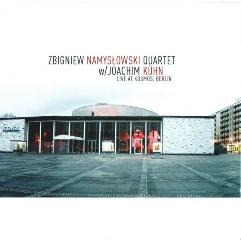Zbigniew Namyslowski Quartet - Live At Kosmos, Berlin (1965)
Zbigniew Namyslowski Quartet - Live At Kosmos, Berlin (1965)

1. Rozpacz 2. Bye Bye Black Cat 3. Balbina 4. Der letzte Tag 5. Szafa 6. Blues Shmues 7. Piatawka 8. Straszna Franka Zbigniew Namyslowski - alto saxophone; Joachim Kuhn - piano; Janusz Koslowski - bass; Czeslaw Bartkowski -drums Recorded live at Filmtheater Kosmos, Berlin, November 30, 1965
This is an iconic recording by the Polish Jazz quartet led by saxophonist Zbigniew Namyslowski, with German pianist Joachim Kühn, bassist Janusz Kozlowski and drummer Czeslaw Bartkowski. Recorded live on November 30, 1965 at the East Berlin Kosmos cinema, this is a quintessential piece of Polish and European modern Jazz history. Of the eight compositions present on this album, seven are by Namyslowski and one is by Kühn.
In order to fully comprehend the meaning of the music captured here, one must in fact look at (and hear) three separate recordings by the Zbigniew Namyslowski quartet spanning a mere one and a half year period, which fully present the history of the Polish Jazz in the making. Starting with the album "Lola", recorded in August 1964 in London, which was the first Jazz album recorded and released beyond the Iron Curtain by an East European artists, followed by this album from late 1965 and finally by the album "Zbigniew Namyslowski Quartet" recorded in January 1966, which was Namyslowski's first recording released as part of the legendary "Polish Jazz" Series.
In the liner notes accompanying this album German critic / historian Bert Noglik describes the historic background and the enormous significance of the modern Polish Jazz, which developed independently, almost isolated from the sources of information and influences, reliant only on sporadic radio broadcasts, few LPs trickling illegally and played till they were flat and ever rarer visits abroad. The fact that the Polish Jazz scene was so incredibly vibrant, inventive and beyond all revolutionary is one of the greatest miracles, which escape any attempt of logical or sociological explanation. But the fact remains that Namyslowski and many other Polish Jazz musicians spontaneously re-invented modern Jazz by daring to go where nobody ventured before.
The presence of the German pianist / composer Joachim Kühn is another fabulous bonus. Kühn would of course become one of the great leaders of the German Jazz scene in the years to come, but first he drifted where the great East European Jazz revolution was happening, living in 1964 in Czechoslovakia and playing with the legendary SHQ led by Karel Velebny and then moved to Poland, where he lived in 1965 and met Namyslowski, only to be invited to sit in the piano chair of his quartet. The following year Kühn, like many other fellow East German musicians, would move over to the West and develop a fabulous musical career of his own.
The music is, of course, absolutely brilliant and the live setting allows for a considerably less constrained treatment of the themes, allowing for truly expanded improvisations, one of which goes beyond the half hour mark, something which was completely unthinkable earlier on. Again, when examining the three a.m. albums, it is interesting to see how the same compositions developed, which of them survived and which were dropped and most interestingly noting Namyslowski's fascination with odd meters, which would become his trademark.
Drummer Bartkowski, who is the only musician present on all the three a.m. recordings alongside Namyslowski, is an outstanding example of how these young musicians developed rapidly, almost overnight. His contribution is an integral part of the music. Bassist Kozlowski, who plays on this album, was also present on the studio album recorded a few months later. His performance is also absolutely top notch.
Surprisingly enough, the sound quality is very decent compared to other archival recordings of that period, which enhances the overall experience of listening to these fabulous recordings. In all honesty there have been very few other archival Polish Jazz discoveries, if any at all, which are comparable to this monumental document. The fact that this music was buried for over forty years is a crime, but now that it finally sees the light of day, all serious music connoisseurs should be absolutely delighted. Such gems are as rare as the Koh-i-Noor and should be treated accordingly. Absolutely essential! ---Adam Baruch, polish-jazz.blogspot.com
download (mp3 @320 kbs):
uploaded yandex 4shared mega mediafire zalivalka cloudmailru oboom uplea








